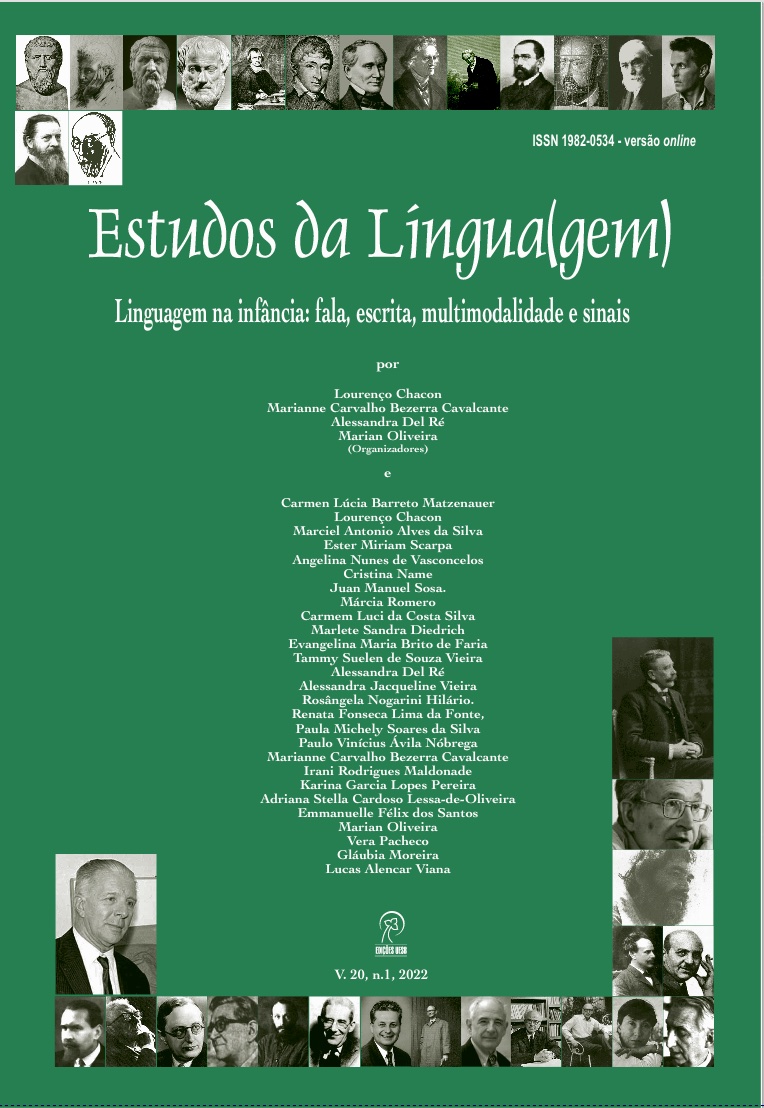Prosody and discursive functions of questions in Infant-Directed Speech
Keywords:
Infant-directed speech; Questions; Prosody; Discursive functions; Language acquisition.Abstract
We investigated interrogatives produced in infant-direct speech by adults interacting with Brazilian babies. IDS shows syntactic, lexical, prosodic changes and high rate of questions. We collected data from four babies (aged from 4 to 12 months-old) and their caregivers and characterized the questions in their prosodic aspects and discursive functions. We found that most questions were marked by one or more prosodic features. Initially, the questions seek to engage the baby, are rhetorical and quite highlighted. At six months, the number of semi-rhetoric ones, which aim to verify understanding, grows. At ten months, full questions, seeking new information and clear answers, increase. The results suggest that the interrogative functions are in line with the development of the baby's ability to dialogue with the adult, with prosody playing an important role in highlighting distinctions between utterances and intentions of the adult, potentiating the baby's cognitive, linguistic, affective and social development.
Downloads
References
BARBOSA, P. G. Características da fala materna e suas implicações para a aquisição inicial do vocabulário. 2013. 72f. Dissertação de Mestrado em Psicologia, Universidade Federal de Minas Gerais, Belo Horizonte, 2013.
BOERSMA, P; WEENINK, D. Praat: doing phonetics by computer [Computer program]. Versão 6.1.08. Disponível em http://www.praat.org. Download realizado em setembro de 2019.
BRAUN, B., DEHÉ, N.; NEITSCH, J.; WOCHNER, D.; ZAHNER, K. The prosody of rhetorical and information-seeking questions in German. Language and Speech, v. 62, n. 4, p. 779-807, 2018.
BRENTARI, D.; FALK, J.; WOLFORD, G. The acquisition of prosody in American Sign Language. Language, v. 91, n. 3, p. e144-e168, 2015. DOI: 10.1353/lan.2015.0042.
CAVALCANTE, M. C. B. Da voz à língua: a prosódia materna e o deslocamento do sujeito na fala dirigida ao bebê. 1999. 239f. Tese de Doutorado em Linguística, Universidade Estadual de Campinas, Campinas, 1999.
CAVALCANTE, M. C. B.; BARROS, A. T. M. Manhês: Qualidade vocal e deslocamentos na dialogia mãe-bebê. Veredas Revista de Estudos Linguísticos, v. especial, p. 25-39, 2012.
CHIANG, C.; GEFFEN, S; MINTZ, T. Distinguishing questions and statements using sentence-initial prosodic cues. In: BERTOLINI, A. B.; KAPLAN, M. J. (Eds.) Proceedings of the 42nd Annual Boston University Conference on Language Development. Somerville, MA: Cascadilla Press, 2018. p. 153-158.
COOPER, R.; ASLIN, R. Preference for infant-directed speech in the first month after birth. Child Development, v. 61, n. 5, p. 1584-1595, 1990.
DADALTO, E.; GOLDFELD, M. Características do maternalês em duas crianças de idades distintas. Distúrbios da Comunicação, v. 18, n. 2, p. 201-208, 2006.
DE PABLO, I; MURILLO, E.; ROMERO, A. The effect of infant-directed speech on early multimodal communicative production in Spanish and Basque. Journal of Child Language, v. 47, p. 457-471, 2020.
DEHÉ, N.; BRAUN, B. The prosody of rhetorical questions in English. English Language and Linguistics, p. 1-29, 2019. DOI: https://doi.org/10.1017/S1360674319000157.
FERNALD, A. Human maternal vocalizations to infants as biologically relevant signals: An evolutionary perspective. In BARKOW, J.; COSMIDES, L.; TOOBY, J. (Eds.) The adapted mind. Evolutionary psychology and the generation of culture. Nova York: Oxford Univ. Press, 1992. p. 391-428.
FERNALD, A.; TAESCHER, T.; DUNN, J.; PAPOUSEK, M.; BOYSSON-BARDIES, B. D.; FUKUI, I. A cross-language study of prosodic modifications in mothers’ and fathers’ speech to preverbal infants. Journal of Child Language, v. 16, p. 477-501, 1989.
FROTA, S.; BUTLER, J.; VIGÁRIO, M. Infant’s perception of intonation: Is it a statement or a question? Infancy, v. 19, n. 2, p. 194-213, 2014. DOI: https://doi.org/10.1111/infa.12037.
FUKS, O. Multimodal motherese in Israeli sign language. TISLR13, 2019. DOI: 10.13140/RG.2.2.30585.42081.
GARNICA, O. K. Some prosodic and paralinguistics features of speech to young children. In: SNOW, C. E; FERGUSON, C. A. (Eds). Talking to children: Language input and acquisition. Cambridge: Cambridge University Press, 1977. p. 63-88.
GEFFEN, S.; MINTZ, T. Prosodic differences between declaratives and interrogatives in infant-directed speech. Journal of Child Language, v. 44, p. 968-994, 2017.
GOMES DA SILVA, C.; CARNAVAL, M.; MORAES, J. A. Atos de fala diretivos em português e em espanhol: uma análise acústica comparativa. Entrepalavras, v. 10, n. 1, p. 326-345, 2020. DOI: http://dx.doi.org/10.22168/2237-6321-11751.
KALASHNIKOVA, M.; KEMBER, H. Prosodic cues in infant-directed speech facilitate young children’s conversational turn predictions. Journal of Experimental Child Psychology, v. 199, p. 1-16, 2020. DOI: https://doi.org/10.1016/j.jecp.2020.104916.
MORAES, J. A. A entoação modal brasileira: fonética e fonologia. Cadernos de Estudos Linguísticos, n. 25, p. 101-111, 1993. DOI: https://doi.org/10.20396/cel.v25i0.8636887.
MORAES, J. A. The pitch accents in Brazilian Portuguese: analysis by synthesis. In: BARBOSA, P.; MADUREIRA, S.; REIS, C. (Eds.) Proceedings of Speech Prosody 2008. Campinas: LBASS, 2008. p. 389-397.
MORAES, J. A.; COLAMARCO, M. Você está pedindo ou perguntando: uma análise entonacional de pedidos e perguntas no português do Brasil. Revista de Estudos Linguísticos, v. 15, n. 2, p. 113-126, 2007.
NAME, C.; SOSA, J.M. Cadê o amor da mamãe? As interrogativas na fala dirigida à criança adquirindo o PB. Veredas Revista de Estudos Linguísticos, v. 24, n. 1, p. 72-93, 2020.
NARAYAN, C.; McDERMOTT, L. Speech rate and pitch characteristics of infant-directed speech: Longitudinal and cross-linguistic observations. The Journal of the Acoustical Society of America, v. 139, p. 1272-1281, 2016. DOI: https://doi.org/10.1121/1.4944634.
NASATAKA, N. Motherese in a signed language. Infant Behavior and Development, v. 15, n. 4, 453-460, 1992.
NEWPORT, E. Motherese: the speech of mothers to young children. In Castellan, N. J.; Pisoni, D. B.; Potts, G. R. (Eds). Cognitive theory. Vol. 2. Hillsdale: Lawrence Erlbaum Ass., 1977. p. 177-217.
NIELSEN, N.M. Expanding Searle’s analysis of interrogative speech acts: a systematic classification based on preparatory conditions. Scandinavian Studies in Language, v. 11, n. 1, p. 7-19, 2020.
NUNES, V. A prosódia de sentenças interrogativas totais nos falares catarinenses e sergipanos. 2015. 563f. Tese de Doutorado em Linguística, Universidade Federal de Santa Catarina, Florianópolis, 2015.
PESSÔA, L.; MOURA, M. L. Fala maternal dirigida à criança em cenários comunicativos específicos: um estudo longitudinal. Psicologia: Teoria e Pesquisa, v.2, n.4, p. 439-447, 2011.
RÄSÄNEN, O.; KAKOUROS, S.; SODERSTROM, M. Is infant-directed speech interesting because it is surprising? Linking properties of IDS to statistical learning and attention at the prosodic level. Cognition, v. 178, p. 193-206, 2018. DOI: 10.1016/j.cognition.2018.05.015
SAINT-GEORGES, C.; CHETOUANI, M.; CASSEL, R.; APICELLA, F.; MAHDHAOUI, A.; MURATORI, F.; LAZNIK, M.-C.; COHEN, D. Motherese in interaction: At the cross-road of emotion and cognition? (A systematic review). PLoS One, v. 8, n. 10, p. e78103, 2013. DOI: https://doi.org/10.1371/journal.pone.0078103.
SEARLE, J. R. Speech Acts: An Essay in the Philosophy of Language. Oxford: Cambridge University Press, 1969. 226p.
SILVA, I. S.; NAME, C. A sensibilidade de bebês brasileiros a pistas prosódicas de fronteiras de sintagma entoacional na Fala Dirigida à Criança. Letrônica, v. 7, n. 1, p. 4-25, 2014. DOI: https://doi.org/10.15448/1984-4301.2014.1.16855.
SILVA, C. R.; SANTOS, J. C. L. Perguntas retóricas: entre a gramaticalização e a discursivização. Veredas Revista de Estudos Linguísticos, v. 19, n. 2, p. 248-268, 2015.
SNOW, E. C. Mothers’ speech research: from input to interaction. In: SNOW, C. E; FERGUSON, C. A. (Eds). Talking to children: Language input and acquisition. Cambridge: Cambridge University Press, 1977. p. 31-49.
SNOW, E. C. Issues in the study of input: Finetuning, universality, individual and developmental differences, and necessary causes. In: FLETCHER, P.; MACWHINNEY, B. (Eds.) The Handbook of Child Language. Cambridge, MA: Blackwell, 1995. p. 180-193.
SODERSTROM, M.; BLOSSOM, M.; FOYGEL, R.; MORGAN, J. Acoustical cues and grammatical units in speech to to preverbal infants. Journal of Child Language, v. 35, n. 4, 869-902, 2008.
SOLEY, G.; SEBASTIAN-GALLES, N. Infants’ expectations about the recipients of infant-directed speech. Cognition, v. 198, 104214, p. 1-9, 2020. DOI: https://doi.org/10.1016/j.cognition.2020.104214.
SPLENDORE, K.; CONSTANTINI, A. C.; DA SILVA, K. C. Investigação da prosódia e da linguagem na interação mãe-bebê. Working Papers em Linguística, v. 20, n. 1, p. 172-188, 2019. DOI: https://doi.org/10.5007/1984-8420.2019v20n1p172.
SUNDARA, M.; MOLNAR, M.; FROTA, S. The perception of boundary tones in infancy. Proceedings of the 18thInternational Congress of Phonetic Sciences. 2015.
THORSON, J.; BORRAS-COMES, J.; CRESPO-SENDRA, V.; VANRELL, M.; PRIETO, P. The acquisition of melodic form and meaning in yes-no interrogatives by Catalan and Spanish children. Probus, v. 27, n. 1, p. 73-99, 2014. DOI: https://doi.org/10.1515/probus-2013-0019.
WEPPELMAN, T. L.; BOSTOW, A.; SCHIFFER, R.; ELBERT-PEREZ, E.; NEWMAN, R. S. Children’s use of the prosodic characteristics of infant-directed speech. Language and Communication, v. 23, n.1, p. 63-80, 2003.
Downloads
Published
Issue
Section
License

This work is licensed under a Creative Commons Attribution 4.0 International License.

Estudos da Língua(gem) is licensed under a Creative Commons Attribution 4.0 International License.
Authors who publish in the journal Estudos da Língua (gem) agree with the following terms:
The journal Estudos de Língua(gem) maintains the copyrights of the contributions published. These rights include the publication of the contribution and make its content available for free through the portal.









